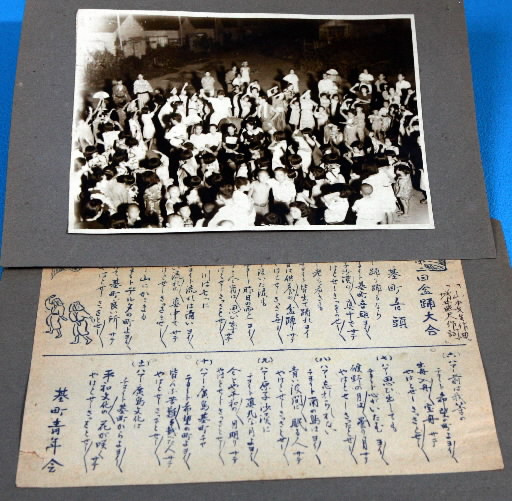The Motomachi District, 65 Years After the Atomic Bombing, Part 1: The Lives of Three Survivors [6]
Jul. 26, 2010
Part 1: The Lives of Three Survivors
Article 6: Hope grows in a desert
by Sakiko Masuda and Junichiro Hayashi, Staff Writers
Dancing during reconstruction era brings smiles to residents
Multistory apartment buildings in Motomachi, a district in Naka Ward, Hiroshima, stand about one kilometer north of the hypocenter of the atomic bombing. Since the day Hiroshima was instantly reduced to ruins in the blast, the residents have reestablished their daily lives in this corner of the city. They have made tremendous efforts to survive and reconstruct the city, seeking to regain a semblance of peace in their world. The past 65 years have been spent with some braving to face the past, memories they would prefer to forget, and others keeping the past hidden away in their hearts. In this special series, the Chugoku Shimbun traces the lives of such A-bomb survivors (hibakusha) of Motomachi.
Multistory apartment buildings in Motomachi, a district in Naka Ward, Hiroshima, stand about one kilometer north of the hypocenter of the atomic bombing. Since the day Hiroshima was instantly reduced to ruins in the blast, the residents have reestablished their daily lives in this corner of the city. They have made tremendous efforts to survive and reconstruct the city, seeking to regain a semblance of peace in their world. The past 65 years have been spent with some braving to face the past, memories they would prefer to forget, and others keeping the past hidden away in their hearts. In this special series, the Chugoku Shimbun traces the lives of such A-bomb survivors (hibakusha) of Motomachi.
In the photo, women dance gaily around a drum while children with their hair bobbed or cropped close look on smiling.
In one unit of a large apartment building that stands in a cluster of apartment buildings in Motomachi, Takeyo Masui, 91, an A-bomb survivor, gazed at the old black-and-white photo and kindled her memories.
"I think they were practicing for the Bon dancing. Perhaps it was a few years after the atomic bomb was dropped."
Ah, Motomachi in Hiroshima
This is a place of hope
In the middle of the atomic desert
Along with the photo, Ms. Masui has preserved a page of mimeographed lyrics. These are the lyrics of "Motomachi Ondo," a dance song for Motomachi, which had as many as 11 verses. The lyrics were written by her husband Teruo, who died in 1997 at the age of 82.
An article in the Chugoku Shimbun dated August 15, 1947, described the song as "the fruit of great efforts which both adults and children can dance to."
Imagining the sentiments her husband imbued in the lyrics, Ms. Masui said: "He was a strong-minded person, but happy to help others. I believe he wanted people to feel hope and joy, since so many died due to the atomic bombing."
Their own home in Minami Town (now, Minami Ward) was flattened by the atomic bomb. Ms. Masui, with Teruo and her mother-in-law, then moved to Motomachi. One of the wooden structures that were being constructed in the area of present-day Hiroshima City Chuo Park became their new home.
Teruo, while working for a company and a supermarket, enjoyed composing haiku, a Japanese-style poem of seventeen syllables. In his later years, too, he continued to compose haiku as he regularly visited a center for senior citizens. A magazine featuring Basho Matsuo, a haiku poet, is still kept in their apartment. Ms. Masui always carries a photo of her late husband in her bag when she goes out. "I feel as if he's watching over me," she said.
Ise Shimojo, 90, a neighbor of Ms. Masui's family and a resident of Motomachi since 1946, looked back fondly on the old days, too. "If I remember right, we had Bon festival dances. We held not only the Bon dancing, but also a variety of events in the district, like a fancy-dress parade."
Prior to the atomic bombing, Ms. Shimojo had evacuated from Hiroshima to her hometown in Nagano Prefecture. But her husband Kensuke, a soldier, experienced the bombing near Hijiyama Hill. (Kensuke died in 2008 at the age of 95.) After the war, Kensuke worked for the Hiroshima Prefectural Government and Ms. Shimojo accepted a position with a local women's association. "We could not allow ourselves luxuries, but we helped one another. My husband often said, 'I prefer peace.'"
In the moonlight in peace
The flowers of peace culture bloom
Teruo also sprinkled the lyrics with the word "peace." His "Motomachi Ondo" disappeared before long due to the redevelopment of the district and other reasons. Now, a new "Motomachi Ondo" with an updated tune and lyrics is loved by residents in the district.
The music and lyrics of the new "Motomachi Ondo" were written by a local folk song group in 1983. Though the song had not been heard for a while, it was revived in 2003. The song will be performed at the Bon festival dance on August 8 this year, too, at Hiroshima Motomachi Elementary School after the memorial service for A-bomb victims is held there.
Motomachi is a pleasant place
A place of greenery
The hope cultivated by the residents has brought about an oasis in the desert. The old and new versions of "Motomachi Ondo" relate the history of reconstruction in the district.
(Originally published on July 22, 2010)







